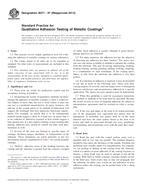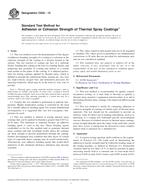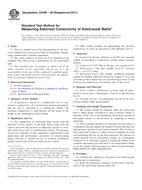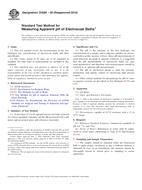Potrebujeme váš súhlas na využitie jednotlivých dát, aby sa vám okrem iného mohli ukazovať informácie týkajúce sa vašich záujmov. Súhlas udelíte kliknutím na tlačidlo „OK“.
ASTM B571-97(2013)
Standard Practice for Qualitative Adhesion Testing of Metallic Coatings
Automaticky preložený názov:
Štandardná prax pre kvalitatívne priľnavosť skúšanie kovových povlakov
NORMA vydaná dňa 1.12.2013
Informácie o norme:
Označenie normy: ASTM B571-97(2013)
Poznámka: NEPLATNÁ
Dátum vydania normy: 1.12.2013
Kód tovaru: NS-7227
Počet strán: 4
Približná hmotnosť: 12 g (0.03 libier)
Krajina: Americká technická norma
Kategória: Technické normy ASTM
Kategórie - podobné normy:
Anotácia textu normy ASTM B571-97(2013) :
Keywords:
adhesion, metallic coatings, ICS Number Code 25.220.40 (Metallic coatings)
Doplňujúce informácie
| Significance and Use | ||||||||||||
|
2.1 These tests are useful for production control and for acceptance testing of products. 2.2 Interpreting the results of qualitative methods for determining the adhesion of metallic coatings is often a controversial subject. If more than one test is used, failure to pass any one test is considered unsatisfactory. In many instances, the end use of the coated article or its method of fabrication will suggest the technique that best represents functional requirements. For example, an article that is to be subsequently formed would suggest a draw or a bend test; an article that is to be soldered or otherwise exposed to heat would suggest a heat-quench test. If a part requires baking or heat treating after plating, adhesion tests should be carried out after such posttreatment as well. 2.3 Several of the tests are limited to specific types of coatings, thickness ranges, ductilities, or compositions of the substrate. These limitations are noted generally in the test descriptions and are summarized in Adhesion Test |
Coating MaterialA |
|||||||||||
|
Cadmium |
Chromium |
Copper |
Lead and |
Nickel |
Nickel and |
Palladium |
Rhodium |
Silver |
Tin and |
Zinc |
Gold |
|
|
Bend |
+ |
− |
+ |
+ |
+ |
+ |
+ |
+ |
+ |
+ |
+ |
+ |
|
Burnish |
− |
+ |
+ |
− |
+ |
+ |
− |
− |
+ |
− |
+ |
− |
|
Chisel/knife |
+ |
+ |
+ |
+ |
+ |
− |
+ |
− |
+ |
+ |
− |
+ |
|
Draw |
− |
− |
+ |
− |
+ |
+ |
− |
− |
− |
− |
+ |
− |
|
File |
− |
+ |
+ |
+ |
+ |
+ |
− |
+ |
+ |
+ |
− |
+ |
|
Grind and |
+ |
+ |
− |
− |
+ |
+ |
+ |
− |
− |
+ |
+ |
− |
|
Heat/quench |
− |
+ |
+ |
+ |
+ |
+ |
− |
− |
+ |
+ |
− |
+ |
|
Impact |
+ |
− |
+ |
− |
+ |
+ |
− |
− |
− |
− |
+ |
− |
|
Peel |
− |
+ |
+ |
− |
+ |
− |
− |
− |
+ |
+ |
− |
+ |
|
Push |
− |
− |
− |
− |
+ |
+ |
− |
− |
− |
− |
+ |
− |
|
Scribe |
− |
− |
+ |
− |
+ |
− |
− |
− |
− |
− |
− |
− |
Coating Material
Chromium,
Nickel, Nickel +
Chromium,
Copper,
Temperature, °C
Tin,
Temperature,
°C
Lead,
Tin/Lead,
Temperature,
°C
Zinc,
Temperature,
°C
Gold and
Silver,
Temperature,
°C
Palladium,
Temperature,
°C
Rhodium,
Temperature,
°C
Steel
250
150
150
150
250
350
185
Zinc alloys
150
150
150
150
150
150
150
Copper and
copper alloys
250
150
150
150
250
350
185
Aluminum and
aluminum alloys
220
150
150
150
220
220
185
2.4 “Perfect” adhesion exists if the bonding between the coating and the substrate is greater than the cohesive strength of either. Such adhesion is usually obtained if good electroplating practices are followed.
2.5 For many purposes, the adhesion test has the objective of detecting any adhesion less than “perfect.” For such a test, one uses any means available to attempt to separate the coating from the substrate. This may be prying, hammering, bending, beating, heating, sawing, grinding, pulling, scribing, chiseling, or a combination of such treatments. If the coating peels, flakes, or lifts from the substrate, the adhesion is less than perfect.
2.6 If evaluation of adhesion is required, it may be desirable to use one or more of the following tests. These tests have varying degrees of severity; and one might serve to distinguish between satisfactory and unsatisfactory adhesion in a specific application. The choice for each situation must be determined.
2.7 When this guideline is used for acceptance inspection, the method or methods to be used must be specified. Because the results of tests in cases of marginal adhesion are subject to interpretation, agreement shall be reached on what is acceptable.
2.8 If the size and shape of the item to be tested precludes use of the designated test, equivalent test panels may be appropriate. If permitted, test panels shall be of the same material and have the same surface finish as the item to be tested and shall be processed through the same preplating, electroplating, and postplating cycle with the parts they represent.
1.1 This practice covers simple, qualitative tests for evaluating the adhesion of metallic coatings on various substances.
1.2 The values stated in SI units are to be regarded as standard. No other units of measurement are included in this standard.
1.3 This standard does not purport to address all of the safety concerns, if any, associated with its use. It is the responsibility of the user of this standard to establish appropriate safety and health practices and determine the applicability of regulatory limitations prior to use.



 ASTM B946-11
ASTM B946-11 ASTM B984-12
ASTM B984-12 ASTM C633-13
ASTM C633-13 ASTM D4370-01(2012)..
ASTM D4370-01(2012).. ASTM D4399-05(2011)..
ASTM D4399-05(2011).. ASTM D4584-05(2010)..
ASTM D4584-05(2010)..
 Cookies
Cookies
